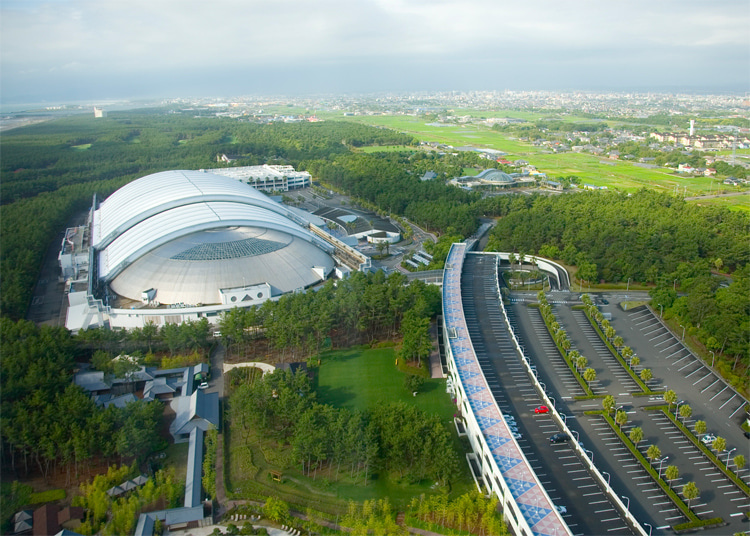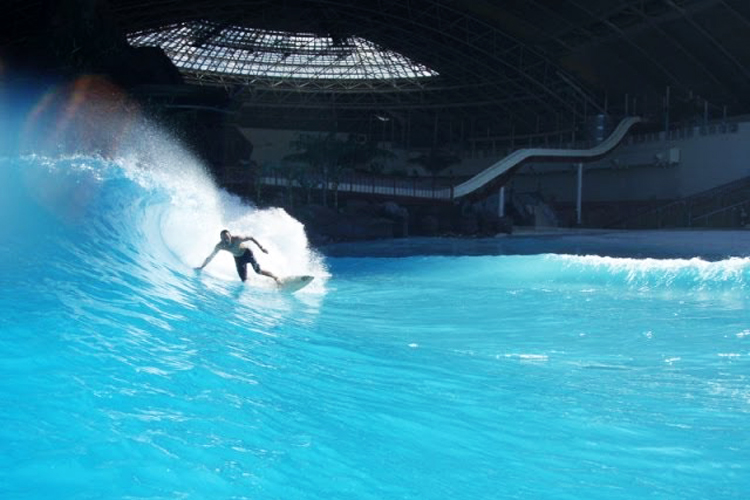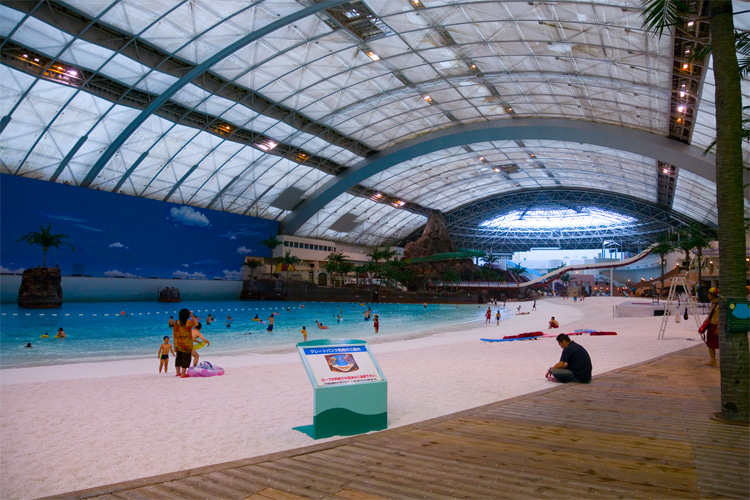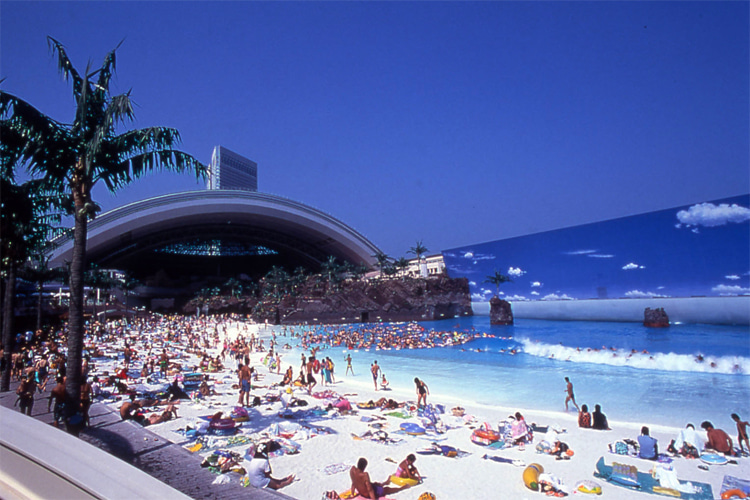In the picturesque confines of Miyazaki, nestled on the southern island of Kyushu, Japan, stood a place of modern wonder - the Seagaia Ocean Dome.
Conceived by the Mitsubishi Heavy Industries (MHI) Group and unveiled in the summer of 1993, this colossal indoor beach and water park came with a breathtaking price tag of $1.8 billion.
It was an investment in audacity, a gamble that promised the beach experience in a controlled environment.
From a surfing perspective, it is still one of the most cherished and iconic wave pools ever built.
However, as breathtaking as it was, the Dome was a financial enigma that never managed to swim into profitable waters.
The splashy inauguration was nothing short of a spectacle, thanks to a grand concert on Halloween night of 1994 by none other than pop-rock legend Sting.
Beyond a one-night appearance, Sting's face graced TV commercials for the resort, a collaboration that reportedly fetched him a payday of about £500,000.
200 Distinct Wave Variations
The Ocean Dome was more than just a water park.
It was a repository of record-breaking feats, including the world's largest indoor pool, which was opened and closed according to the weather conditions, the world's largest retractable roof covering the vast complex, and the world's most sophisticated wave-generating equipment.
It was a tribute to both engineering and ambition.
Its Polynesia-themed glory featured 12,000 square meters of sandy beach unlike any other, crushed to powder from 600 tonnes of marble imported from China.
Its artificial "ocean," six times larger than an Olympic pool, was an engineering marvel, holding 13,500 tonnes of unsalted, chlorinated water warmed to a constant 82.4 °F (28 °C).
But the pièce de résistance?
A wave machine capable of producing 200 distinct wave variations, a spectacle that earned it a place in the Guinness World Records as "the biggest simulated pool."
This ocean was no mere puddle.
Thanks to the Dome's advanced computer systems and a set of mammoth vacuum pumps, waves became tubular formations, a surfer's paradise created with a push of a button.
The marvel didn't stop there: the waves required a staggering 1,800 tons of water for each surfable crest.

Loved by the Surf Pros
It was a feast for the senses, attracting a cadre of world-class surfers, skaters, and snowboarders like Owen Wright, Julian Wilson, Matt Wilkinson, Mitch Coleborn, Heath Joske, Fábio Gouveia, Jay Davies, Benji Weatherley, Tosh Townend, Kalani Robb, Chad Bartie, Todd Richards, and even Tony Hawk, who came to experience this synthetic, yet thrilling, environment.
Former Australian world tour surfer Matthew Pitts performed nightly as Sabu, the valiant sword-wielding surf prince, in the Dome's wave pool shows for at least eight years.
"I have the best job, surfing all day in the ocean, then getting barrelled every night in the Ocean Dome. Plus, I'm getting paid for it!" he stated.
YouTube vlogger EricSurf6, an American resident in Japan for two decades, also joined the action.
He became a staple during holiday seasons, running a quirky yet fascinating Surf Juggling Challenge in the wave pool.
The Global Organization of Bodyboarding (GOB) World Tour even ran an event at the artificial wave piscina during the mid-to-late 1990s.
"The left wedge off the wall was the best wave, for sure. That place was a trip!" recalls former World Tour bodyboarder Jay Reale.
But the Dome was more than waves and surf stunts.
Its cavernous interiors were a tropical fantasy, complete with lush foliage, cascading waterfalls, raft rides, jacuzzis, and an array of theatres and restaurants.
Come nightfall, water screens, and atmospheric lighting turned the space into a tropical paradise, replete with daily festivals, dancing, and live music.
Set within a sprawling 850-acre resort, the Dome was part of a larger ecosystem that included five hotels, an assortment of sporting facilities, golf courses, botanical parks, and a zoo.
The location couldn't be more ironic - the engineering splendor was a mere 300 meters away from an actual beach.

A Financial Downward Spiral
Yet, despite its awe-inspiring beginnings and a grand opening featuring Sting, the project's financial underpinnings were shaky at best.
To merely break even, the Dome needed to attract nearly 15,000 visitors each day.
Admission costs didn't help either; tickets were more expensive than a day at Tokyo Disneyland, i.e., they cost $50 for an adult.
Originally heralded as an entertainment wonder, it soon became apparent that even hordes of initial tourists couldn't keep the Dome afloat.
Saddled in one of Japan's poorest prefectures, local support was also lacking.
The Ocean Dome water park, located about 1,500 kilometers south of Tokyo, was visited by 1.25 million people (around 3,500 per day) in the peak year of fiscal 1995.
In other words, from the get-go, the structure lost around $250 million a year.
The Ocean Dome water park, located about 1,500 kilometers south of Tokyo, was visited by 1.25 million people in the peak year of fiscal 1995.
By February 2001, the dazzling Seagaia found itself drowning in a jaw-dropping debt of almost $4 billion. Blame was abundantly shared during the fallout.
A press conference that followed the bankruptcy saw businessman Muneyoshi Sato and governor Suketaka Matsukata, both senior figures, embroiled in a public game of hot potato, each reluctant to take responsibility for the financial disaster.

The Rebirth and Closure of Seagaia Ocean Dome
In a twist of irony, Ripplewood Holdings, an American private equity fund, acquired the sinking dream for a mere $148 million - a fraction of its original construction cost.
They pumped in an additional $32 million on renovations for the Dome, but even after the remodeling of the resort, the hotel closed down with liabilities of $2.5 million.
The Dome temporarily closed its doors in 2002, reopened for a spell, but finally said its last goodbyes in September 2007 via Phoenix Resort K. K.
Seagaia was never a good deal for Ripplewood and a nightmare for its CEO, Tim Collins.
The waterpark only observed an operating profit in March 2007, and despite reporting a net profit of $6 million in 2010, it wasn't enough to prevent the boat from sinking.
At some point, Ripplewood even considered gifting the wave pool colossus to the city, but the generous offer was eventually coldly withdrawn.
In 2017, the Dome was unceremoniously demolished, making way for the Phoenix Seagaia Resort that stands today.
